People who eat at least two serves of fruit per day are more sensitive to insulin and therefore less susceptible to diabetes than those who eat less than half a serve.
That is the finding from a study of more than 7,500 Australians who took part in the Baker Heart and Diabetes Institute’s AusDiab Study which assessed fruit and fruit juice intake and the prevalence of diabetes after five years.
Type 2 diabetes is a disorder in which the body does not produce enough insulin or becomes insensitive to the hormone. This causes abnormally high levels of glucose in the blood and inadequate amounts of glucose in the cells. Together these cause the symptoms and complications of diabetes which can lead to heart disease, stroke, kidney disease, susceptibility to infections and blindness.
The study’s lead author, Dr Nicola Bondonno, Edith Cowan University (ECU) said the research provided fresh evidence for the health benefits of eating fruit.
“We found an association between fruit intake and markers of insulin sensitivity, suggesting that people who consumed more fruit had to produce less insulin to lower their blood glucose levels,” she said.
“This is important because high levels of circulating insulin (hyperinsulinemia) can damage blood vessels and are related not only to diabetes, but also to high blood pressure, obesity, and heart disease.
“A healthy diet and lifestyle, which includes the consumption of whole fruits, is a great strategy to lower your risk of developing type 2 diabetes.”
“Higher insulin sensitivity and a lower risk of diabetes was only observed for people who consumed whole fruit, not fruit juice,” she said.
“Although 100 per cent fruit juice may contain as much sugar as regular soft drink, it also contains nutrients and phytochemicals from the fruit. However, when you juice a fruit, you remove most of the pulp, and therefore a lot of the fruit fibre.”
Dr Bondonno said that it is unclear exactly how fruit contributes to insulin sensitivity.
“I hypothesise that the benefits of fruit are multifaceted; a combination of fruit fibre, nutrients, phytochemicals (such as flavonoids), and substitution (if you’re eating more fruit you’re probably eating less ‘bad’ foods).
“As well as being high in vitamins and minerals, fruits are a great source of phytochemicals, which may increase insulin sensitivity, and fibre,” she said.
“There are many benefits to consuming fruit fibre. Not only does it help you feel fuller for longer, but it also blunts the rapid rise in blood sugar that comes with consuming foods or beverages containing sugar and is important for gut health. This may explain why we did not observe the same health benefits for people consuming fruit juice in our study, as we did for people consuming whole fruits.
“Most fruits have a low glycaemic index, which means the fruit’s sugar is digested and absorbed into the body more slowly.”
More than 450 million people worldwide are living with type 2 diabetes and further 370 million people are at increased risk of developing type 2 diabetes.
The research was published in the Journal of Clinical Endocrinology and Metabolism, last month.



































